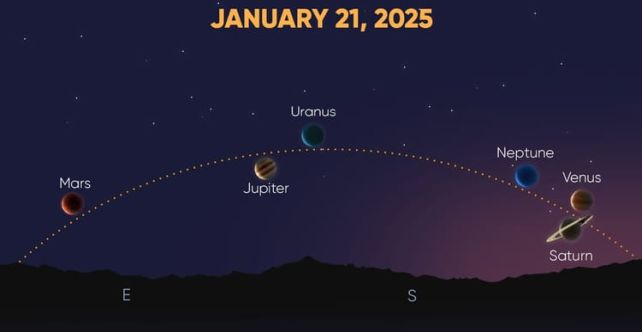A very rare treat is about to grace Earth's night skies.On the evening of 28 February 2025, all seven of the other planets in the Solar System will appear in the night sky at the same time, with Saturn, Mercury, Neptune, Venus, Uranus, Jupiter, and Mars all lining up in a neat row – a magnificent sky feast for the eyes known as a great planetary alignment.But that's not all. Between now and then, on 21 January 2025, six of the seven other planets will appear in the sky at once in a large alignment – Mars, Jupiter, Uranus, Neptune, Venus, and Saturn, with the exception of Mercury.

An illustration of the upcoming January planetary alignment as seen from the Northern Hemisphere. (Star Walk)
Actually, it's not uncommon for a few planets to be on the same side of the Sun at the same time, but it's less common for most, or even all of the planets to align.Any number of planets from three to eight constitutes an alignment. Five or six planets assembling is known as a large alignment, with five-planet alignments significantly more frequent than six.Seven-planet great alignments are, of course, the rarest of all. READ MORE...
Astronomers may have detected a dozen large objects lurking beyond the Kuiper Belt at the edge of our solar system, suggesting there could be another equally massive, "second Kuiper Belt" hiding beyond the orbit of Pluto.
Researchers may have detected a dozen new, large objects beyond the Kuiper Belt, which suggests that there is lots more stuff in the solar system than we realized. It could even hint that there is a "second Kuiper Belt" further out toward the edge of our stellar neighborhood, Science.org reported.
The sun's influence reaches much further out into space than the eight planets that orbit around it. Beyond Neptune, the solar system stretches out to around 100 astronomical units (AU), which is 100 times the distance between Earth and the sun. For context, the most distant planet from the sun, Neptune, is roughly 30 AU from our home star.
Beyond the edge of the solar system, or heliopause, lies the Oort Cloud — a reservoir of comets and asteroids that are loosely contained by the sun's gravity — that stretches to at least 1,000 AU from the sun, and likely even further.
But a majority of the largest known asteroids, comets and other large objects that lie beyond Neptune's orbit are contained within the Kuiper Belt, which stretches between 30 and 50 AU from the sun.
Famous residents of the Kuiper Belt include the dwarf planet Pluto and the double-lobed object Arrokoth — the most distant object visited by a spacecraft. Planet Nine, if it exists, would also lurk somewhere within the Kuiper Belt.
Until now, very few massive objects in the solar system have been found beyond the Kuiper Belt. READ MORE...
The CHEOPS satellite accidentally spotted a rare exoplanet with no known equivalent. The satellite detected this unique exoplanet while looking for two exoplanets in a bright nearby star system.
This planet called ‘Nu2 Lupi d’ is located 50 light-years away in the constellation Lupus (Latin for Wolf), around a star called Nu2 Lupi. It is about 2.5 times the size of Earth and almost 9 times its mass.
What’s more, scientists used measurements with archival data from other observatories and numerical models to characterize the density and composition of the planet and its neighbors.
They found that the planet has a rocky interior. It has far more water than the Earth. However, the water is not liquid; instead in the form of high-pressure ice or high-temperature steam, making the planets uninhabitable.
In 2019, Swiss astronomers announced the detection of three exoplanets around this bright, Sun-like star.
The three exoplanets have masses between those of Earth and Neptune (17 times the Earth) and take 12, 28, and 107 days to circle their parent star.
Yann Alibert, professor of astrophysics at the University of Bern and co-author of the study, said, “We knew that already for the two inner planets, which led us to point CHEOPS to the system in the first place.
However, the third planet is quite far away from the star; no one was expected to see its transit!” READ MORE



